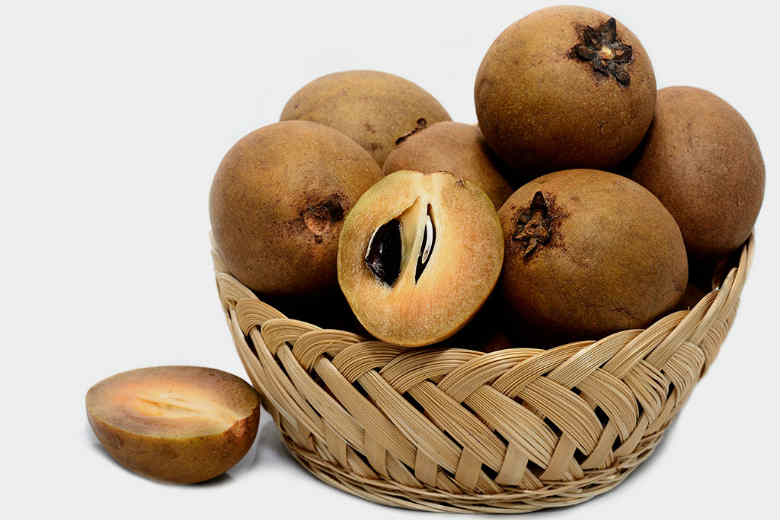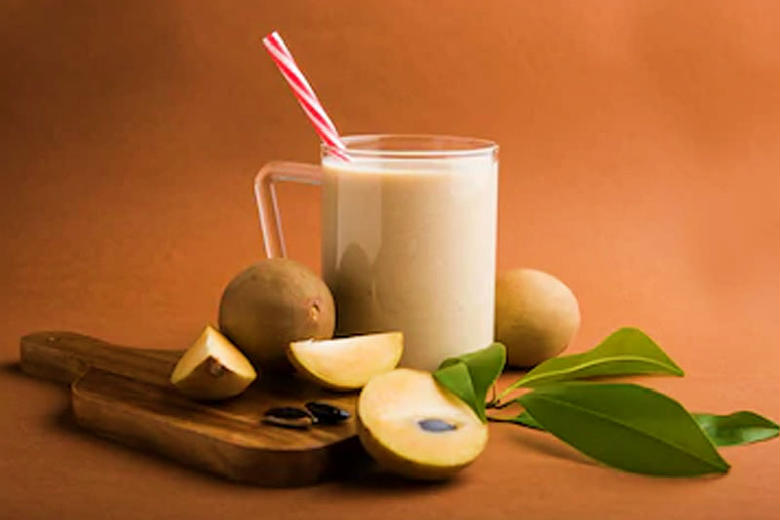Chikoo, or sapota, is one of those tasty tropical fruits that most Indians love to enjoy. And why not? Apart from mango, a few fruits have soft and sweet pulp, like chikoo. It also offers many health benefits, just like other healthy fruits. If you are a beauty enthusiast who loves to take care of her skin and hair with natural ingredients, chikoo can help you with that, too. But above all, this fruit can be a savior for all those overweight people who have been struggling with their excess body fat. This simple fruit can help you naturally shake off a lot of pounds. This article will focus on the benefits of eating chikoo (sapodilla) for weight loss, how to include it in your diet, and all other essential things to consider. (1)
What Is Chikoo (Sapodilla)?
Chikoo (scientifically named Manilkara Zapota), known as ‘sapota’ or ‘sapodilla,’ is obtained from a tall evergreen tea with glossy, oblong leaves and bell-shaped white flowers. Though the tree, belonging to the Sapotaceae family, is native to the rain forests of Central America, Mexico, and the Caribbean, it is widely available worldwide. Four different types of chikoo plants include Russel, Brown Sugar, Tikal, and Prolific Sapodilla.
Chikoo is a small, round, or oval-shaped, deliciously sweet berry that measures approximately 0.5 inches in diameter and weighs nearly 150 grams. The nutrient- and calorie-rich fruit has thin, hard skin that is pale yellow to brown. It also has 2-5 shiny black bean-like seeds in the center. The edible flesh of the fruit is soft, delicate, and easy to digest. It has a smooth and grainy texture with a lovely and musky flavor, attributable to its high fructose and sucrose content.
The pulp of unripe chikoo is white in color due to the high amount of latex in it. As the fruit ripens, the latext content reduces and the color changes to brown.
Read Also – How To Use Amla For Weight Loss
Nutritional Value Of Chikoo (Sapodilla)
Chikoo comes loaded with essential nutrients, vitamins, minerals, and antioxidants, making it a healthy fruit. Here is a breakdown of the nutritional value of chikoo:
| TYPE | NAME | QUANTITY (per 100 g) |
| Macronutrients | Energy | 83 Kcal |
| Dietary Fiber | 5.3 g | |
| Fat | 1.10 g | |
| Carbohydrate | 19.9 g | |
| Protein | 0.44 g | |
| B Group Vitamins | Niacin (B3) | 0.200 mg |
| Pantothenic acid (B5) | 0.252 mg | |
| Pyridoxine (B6) | 0.037 mg | |
| Riboflavin (B2) | 0.020 mg | |
| Thiamin (B1) | 0.058 mg | |
| Other Vitamins | Folate | 14 mcg |
| Vitamin A | 60 IU | |
| Vitamin C | 14.7 mg | |
| Electrolytes | Sodium | 12 mg |
| Potassium | 193 mg | |
| Minerals | Calcium | 21 mg |
| Copper | 0.086 mg | |
| Iron | 0.80 mg | |
| Magnesium | 12 mg | |
| Phosphorous | 12 mg | |
| Selenium | 0.6 mcg | |
| Zinc | 0.10 mg | |
| Lipids | Saturated fatty acids | 0.33 g |
| Monounsaturated fatty acids | 0.89 g | |
|
Polyunsaturated fatty acids |
0.02 g |
Why Eat Chikoo (Sapodilla) For Weight Loss?
While chikoo does not directly affect our body weight, it can indirectly help us burn a lot of fat. Here are three main ways the fruit works to aid in weight loss:
1. Facilitates Bowel Movement
Chikoo is very high in dietary fiber, which makes it an excellent laxative. It aids in bowel movement through the gastrointestinal tract, facilitating digestion, reducing abdominal gas, and curing constipation—all these help in losing weight faster as well as in an effective way.
Also Read – The Leptin Diet For Weight Loss: A Beginner’s Guide
2. Promotes Healthy Digestion
Chikoo improves our metabolism significantly by boosting the natural process of digestion and reducing various gastrointestinal issues. This is essential for promoting weight loss and averting obesity.
3. Detoxifies The Body
Chikoo is loaded with antioxidant vitamin C, which adds to its detoxifying properties. The fruit can help our body eliminate toxic materials, which smoothens our weight loss journey.
How To Eat Chikoo (Sapodilla) For Weight Loss?
The most common way of eating chikoo for weight loss is to peel out the fruit’s skin, bisect it longitudinally, remove the seeds (discard them), and consume the soft, juicy pulp directly. Having raw fruit with its skin is considered the healthiest choice for adults and babies. However, if you dislike eating the fruit directly, try out its juice or blend it in your milkshake for some tasty variations. Chikoo can also be used in jams, jellies, and ice creams for added flavor and weight loss benefits. You can even add it to your bowl of cereals.
Read Also – These Recipes Of Kalonji Seeds For Weight Loss Will Give You A Slim-Trim Look
How To Select Chikoos For Weight Loss?
Chikoo is not a seasonal fruit, so that you can consume it all year. But when it comes to meeting a specific goal, i.e., losing weight with its help, you must ensure you buy the right ones to reap the maximum benefits. Here are a few tricks to select the right chikoo for weight loss:
- Choose fresh, soft, and well-shaped chikoos with smooth skin and a nice brown color.
- Chikoos, which are ripe enough, are always the best to pick. Press the fruit gently with your thumb to test its ripeness when buying. If, by any chance, you end up purchasing raw chikoos, put them in a rice bag for two consecutive days to ripen them.
- Ensure you do not purchase hard, rotten, or leaking chikoos from the market. Also, try to avoid ones that are bruised, spotted, deformed, or have wrinkled skin.
How To Store Chikoo (Sapodilla)?
You should always consume chikoo within 3 to 4 days after buying. They can be kept at room temperature for this period. However, if you need to store chikoos for some more days, put them in a refrigerator or any other cool, dry place.
Read Also – Beans – Are They A Boon Or Bane For Weight Loss?
Side Effects Of Chikoo (Sapodilla)
Chikoo is a healthy and nutritious fruit that does not cause any adverse effects when consumed in moderation. However, overeating of chikoo can lead to several issues, including stomach pain and abdominal discomfort. Being very high in calories can also interrupt your weight loss efforts by adding extra pounds to your body. In addition, raw chikoos are high in chemical compounds like tannins and latex, which cause mouth irritation, itching in the throat, breathing problems, mouth ulcers, and so forth.
Frequently Asked Questions (FAQs)
How Many Chikoos Should You Eat A Day For Weight Loss?
The recommended daily intake of chikoo might vary from person to person based on their unique weight loss goals. However, you should not consume more than 100-120 g of fruit daily.
Can A Diabetic Eat Chikoo?
If you have diabetes, you should avoid chikoo for weight loss. The fruit has high levels of sugar and very high calories, which can increase the sugar levels in your bloodstream. As a result, your diabetes can become worse over time.
Is Chikoo Good for Health?
Chikoo is extremely good for our health. It boosts digestion, cures constipation, reduces inflammation, increases energy, improves vision, heals cold and flu, keeps bones healthy, eases pregnancy-related symptoms, detoxifies the body, and prevents certain cancers. To know more, please read 15 Great Health Benefits Of Chikoo Or Sapodilla.
Is Chikoo Good For Skin And Hair?
Chikoo is a fantastic source of vital nutrients, vitamins, minerals, and antioxidants. Hence, regular consumption of this fruit can nourish the skin and scalp from within. As a result, your overall appearance becomes enhanced to a great extent.
Read Also – 5 Sprouts And Their Health Benefits For Weight Loss



